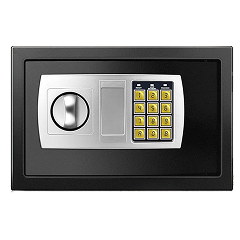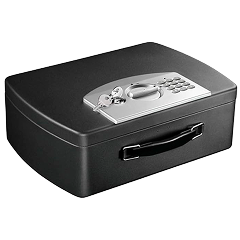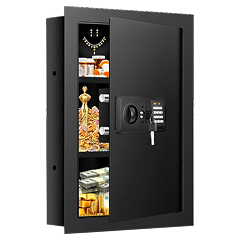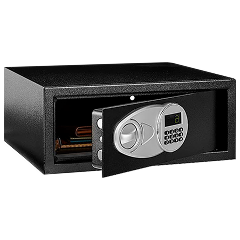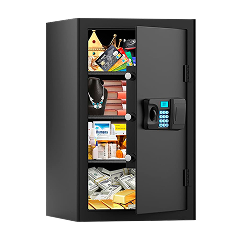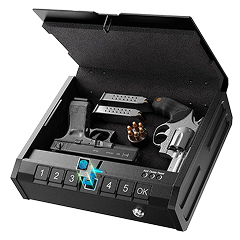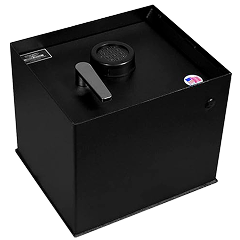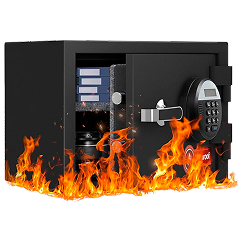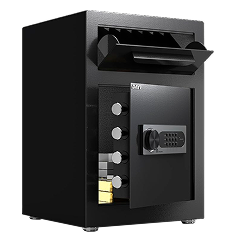Après avoir possédé pendant plusieurs années deux petits coffres-forts (un modèle à combinaison traditionnelle et un coffre-fort portable ignifugé), j’ai commencé à me renseigner sur les coffres-forts muraux lorsque j’ai réalisé que j’avais besoin de quelque chose de plus discret et permanent pour mes documents importants.
Mes coffres-forts actuels fonctionnent bien, mais étant posés dans un placard, ce sont des cibles évidentes, et le coffre à combinaison de 35 kg n’est pas vraiment difficile à voler si quelqu’un a suffisamment de temps. Un coffre-fort mural permet quant à lui de cacher complètement des objets de valeur derrière un tableau ou un meuble.
Il y a trois principales différences entre un coffre-fort mural et un modèle classique : ils se fixent dans les montants du mur, vous pouvez réellement les dissimuler, et vous sacrifierez un peu de votre protection contre le feu au profit de cette dissimulation.
Ce guide couvre ce qui compte vraiment lors de l’achat : l’épaisseur du mur nécessaire, à quoi ressemble la fixation, et le choix du bon type de serrure. Je l’ai rédigé pour apporter des informations que vous ne trouverez pas dans les guides généralistes sur les coffres-forts.
Comprendre les classifications de sécurité des coffres-forts muraux
Les fabricants utilisent des termes de sécurité qui sonnent bien, mais ne veulent souvent rien dire… et le système de classification n’est pas franchement très clair.
Classement américain RSC (Residential Security Container)
La certification RSC est une norme américaine, qui signifie que le coffre-fort a survécu à un test d’effraction standardisé mettant en œuvre des outils à main courants et des leviers pendant cinq minutes. Cela peut sembler court, mais les cambrioleurs veulent généralement entrer et sortir rapidement.
Lors de mes recherches, les coffres-forts certifiés RSC par l’organisme UL (Underwriters Laboratories) ont systématiquement surpassé les modèles non certifiés, et les tests reproduisent réellement des tentatives d’effraction plutôt que des scénarios inventés. Les tests RSC ciblent les menaces domestiques, utilisant simplement des outils à main et des leviers, et non les attaques sophistiquées couvertes par les classifications commerciales.
En Europe, des certifications domestiques existent également (Norme européenne EN 14450, classes S1 et S2), et la France utilise également la Certification A2P.
Certifications tierces
J’écarte tout coffre-fort accompagné de termes marketing creux comme « construction en acier » ou « certifié sécurité » s’il n’y a pas un vrai numéro de certification officielle que je peux vérifier. Les entreprises font des affirmations extravagantes sur la sécurité, mais les normes officielles permettent de tester réellement les coffres-forts et d’obtenir des résultats fiables.
En comparant les caractéristiques côte à côte, les coffres avec de vraies certifications avaient un acier plus épais, de meilleures serrures et des systèmes de fixation plus robustes que ceux misant sur un langage marketing flatteur.
Impact de la fixation murale sur la sécurité
Installer un coffre-fort dans un mur modifie son profil de sécurité par rapport aux modèles au sol, car les voleurs ne peuvent pas l’attaquer sous tous les angles ni l’emporter facilement. La qualité de votre installation fait donc partie intégrante de la sécurité.
Si la fixation est mal réalisée, un coffre-fort mural pourra être arraché plus facilement que forcé. Les cavités murales limitent aussi l’épaisseur de la paroi du coffre, ce qui pousse ces coffres à miser sur la solidité de la porte et des serrures plutôt que d’égaler l’épaisseur d’acier des gros modèles au sol.
Profondeur d’encastrement et exigences de montage
Si vous vous trompez dans les mesures, vous pourriez vous retrouver avec un coffre qui dépasse du mur ou être forcés à entreprendre de lourds travaux non prévus. Les cloisons intérieures standard offrent environ 9 cm de profondeur, mais les coffres-forts muraux nécessitent généralement entre 7,5 et 15 cm, selon leur capacité et leur résistance au feu.
J’ai vu trop de personnes s’enthousiasmer pour un modèle précis pour ensuite découvrir que leur mur ne pouvait pas l’accueillir sans retirer le placo des deux côtés ou risquer de toucher des câbles électriques.
L’exigence de profondeur ne concerne pas uniquement le corps du coffre : il faut aussi prévoir l’espace pour la visserie et d’éventuels matériaux isolants. Les coffres-forts muraux certifiés ignifugés ont tendance à être plus profonds à cause des couches d’isolation, tandis que les modèles axés uniquement sur la sécurité peuvent souvent s’intégrer dans les cavités murales standard.
Points clés pour l’installation :
- Murs en ossature bois standard en 2×4 : profondeur maximale de 9 cm, adaptée uniquement aux coffres basiques de sécurité.
- Construction en ossature bois en 2×6 : profondeur de 14 cm permettant d’accueillir des modèles ignifugés.
- Murs en maçonnerie/béton : découpe sur mesure nécessaire, installation professionnelle recommandée.
- Murs porteurs : consultation d’un ingénieur structurel avant toute chose.
- Conflits électricité/plomberie : toujours vérifier la présence de conduites ou câbles avant toute chose.
- Espacement des montants : coffres conçus pour un entraxe standard de 40 cm, certains acceptent un entraxe de 60 cm.
- Matériel de fixation : au minimum, utiliser de solides tire-fonds fixés dans les montants. Certains modèles nécessitent des boulons traversants.
Compromis liés au type de serrure pour coffre-fort mural
Choisissez le mauvais type de serrure, et vous devrez rouvrir votre mur lorsqu’elle vous lâchera. J’ai utilisé une serrure à combinaison traditionnelle pendant des années et j’apprécie le fait que les serrures mécaniques n’aient pas besoin de piles ni de composants électroniques susceptibles de rendre l’âme, même si elles sont clairement plus lentes lorsqu’on a besoin d’un accès rapide.
Comparaison des types de serrures pour coffre-fort mural encastrable
Capacité et fonctionnalités d’organisation
Avec un coffre-fort mural, il faut penser l’espace de stockage différemment. Vous êtes limité par la profondeur de votre mur. La plupart offrent un volume intérieur compris entre environ 8 et 50 litres. Ça paraît minuscule, non ? Mais quand je regarde ce qu’il faut vraiment cacher (documents, bijoux, un peu d’argent liquide), c’est largement suffisant.
Mon petit coffre-fort mural ignifugé fait environ 15 litres et contient sans problème nos passeports, certificats de naissance, documents d’assurance et bijoux.
Impossible d’y entasser tout en vrac pour trier plus tard comme dans un grand coffre. Les pochettes sur porte empêchent les petits objets de se perdre dans les coins, tandis que les étagères réglables conviennent aussi bien aux dossiers qu’aux boîtes à bijoux. La protection contre le feu atteint généralement 30 à 60 minutes, contre 1 à 2 heures pour les gros modèles. Mais c’est souvent suffisant puisque, dans la plupart des incendies domestiques, les pompiers interviennent en moins de 30 minutes.
Principaux points à considérer pour la capacité :
- Stockage de documents : les dossiers classiques nécessitent au moins 36 cm de largeur, le format A4 seulement 30 cm.
- Organisation des bijoux : visez des compartiments doublés de feutre, ou avec des plateaux amovibles.
- Stockage mixte : des étagères réglables permettent de ranger à la fois des documents plats et de petites boîtes.
- Organisateurs de porte : pochettes et pinces optimisent l’espace pour les objets utilisés fréquemment.
- Limites de profondeur : les modèles ignifugés sacrifient de l’espace intérieur à cause de l’épaisseur de l’isolation.
Sens d’ouverture de la porte et orientation du clavier
Le sens d’ouverture compte beaucoup plus pour un coffre-fort mural que pour un modèle portable, car vous ne pouvez pas le tourner une fois installé. Après la pose, tout est définitif. Cela devient problématique si vous l’installez dans un coin ou près d’un meuble : si l’ouverture est du mauvais côté, vous risquez de constamment heurter un obstacle ou de rendre votre accès personnel difficile.
Vous pouvez opter pour des charnières à gauche ou à droite, et certains modèles ont des portes réversibles, mais il faut planifier cela avant d’ouvrir le mur. L’emplacement du clavier varie : certains sont placés sur la porte, d’autres sur le côté, et quelques-uns peuvent pivoter après installation.
Les portes encastrées augmentent la résistance face à un levier, mais le clavier se retrouve plus profondément dans le mur, ce qui peut le rendre moins accessible selon l’emplacement et le mobilier environnant.
Erreurs à éviter
Les histoires cauchemardesques d’installation sont généralement dues à quatre erreurs de planification commises avant même l’achat du coffre-fort.
- Profondeur de montage insuffisante : achat d’un coffre qui ne rentre pas dans votre mur sans gros travaux. Mesurez la profondeur réelle et tenez compte de la visserie avant de craquer pour un modèle.
- Choix d’un modèle trop petit pour vos besoins futurs : commencer avec juste assez d’espace garantit que vous en manquerez rapidement, et l’agrandissement nécessitera de rouvrir le mur ou de gros travaux.
- Aucune vérification de la structure du mur : supposer que votre mur supportera un coffre chargé sans vérifier la présence de montants solides et l’absence de réseaux (câbles, canalisations) risque de vous mener tout droit vers des problèmes.
- Matériel de fixation bon marché : remplacer la visserie spécifiée par des boulons au hasard annule l’intérêt d’avoir investi dans un coffre de qualité.
Budget et valeur à long terme
Les prix d’un coffre-fort mural varient énormément, donc comprendre ce que vous payez réellement permet d’économiser de l’argent et d’éviter d’acheter de la camelote.
Gammes de prix et ce qu’elles offrent
Les modèles basiques sans protection contre les incendies coûtent entre 100 et 150 € et offrent une construction en acier avec une serrure simple, mais ce sont essentiellement des boîtes métalliques qui empêchent les curieux plutôt que de véritables tentatives de vol.
La tranche idéale de 250 à 500 € correspond à des coffres certifiés avec un acier plus épais, de meilleures serrures et souvent une protection contre le feu. C’est ce que je viserais, pour un usage domestique. Au-delà de 500 €, on paie pour du haut de gamme, avec par exemple une protection incendie prolongée, des serrures biométriques ou des caractéristiques commerciales dont un particulier n’a pas vraiment besoin.
Coût d’installation professionnelle
Comptez entre 150 et 450 € pour une installation professionnelle, selon le type de mur et les tarifs pratiqués localement, si vous n’êtes pas à l’aise avec l’électricité et l’ouverture d’un mur. Ce coût est souvent justifié. J’ai vu des catastrophes en bricolage qui ont coûté bien plus cher que de simplement faire appel à un pro, sans compter que les garanties exigent souvent une installation conforme. Les installateurs arrivent avec les outils adaptés pour découper proprement et savent gérer les câbles électriques ou la plomberie.
Valeur à long terme et garantie
Un bon coffre-fort mural peut durer des décennies sans souci, ce qui permet d’amortir son coût initial sur de nombreuses années. Les fabricants sérieux garantissent les composants mécaniques pendant 1 à 3 ans et la protection ignifugée à vie, mais une installation ratée annule la plupart des garanties. La véritable valeur vient de la tranquillité d’esprit, et ces coffres ne deviennent pas obsolètes comme les appareils électroniques.
L’indispensable pour choisir un coffre-fort mural
Restez concentrés sur l’essentiel plutôt que de vous laisser séduire par des options tape-à-l’œil ou un discours commercial.
- Cherchez de vraies certifications de sécurité, avec une certification officielle vérifiable, pas des formules creuses comme « certifié sécurité » ou « aussi fort qu’un coffre de banque ».
- Assurez-vous que la fixation est compatible avec votre mur, et choisissez une serrure en fonction du niveau de sécurité nécessaire et de la fréquence d’accès. Prenez plus grand que prévu, car agrandir plus tard implique des travaux.
- Choisissez un coffre qui disparaît dans votre mur et fonctionne de manière fiable pendant des décennies tout en protégeant ce qui compte pour vous. Les meilleurs sont installés une fois, puis oubliés jusqu’au moment où vous en avez besoin.
- Investissez dès le départ dans une construction solide, une installation correcte et une planification réaliste de la capacité requise.
- Évitez les gadgets si cela compromet l’essentiel, et gardez en tête qu’un bon coffre-fort mural devient une infrastructure de sécurité permanente, pas un appareil de plus à entretenir.


